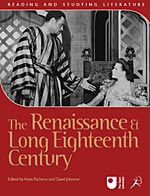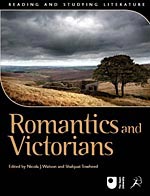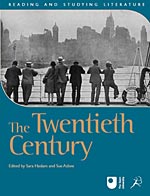Arts Course Information
Reading and studying literature (A230)
Study materials
Book 1: The Renaissance and the Long Eighteenth Century
 Part 1 of this book, Love and Death in the Renaissance, deals with a literary period still famous for its experiments in the writing of tragic drama. We study two well-known examples written in the early years of the seventeenth century, William Shakespeare’s Othello and John Webster’s The Duchess of Malfi. Both plays are about marriages for love that violate social norms and are subsequently punished. We consider how the two dramatists depict these forbidden marriages and the ways in which they invest them with tragic meaning. We focus on the two themes of love and death, but we also explore other related themes of the plays, such as race and class. This first part is designed to hone your skills of textual analysis; it will also enable you to begin thinking about plays as texts written for performance.
Part 1 of this book, Love and Death in the Renaissance, deals with a literary period still famous for its experiments in the writing of tragic drama. We study two well-known examples written in the early years of the seventeenth century, William Shakespeare’s Othello and John Webster’s The Duchess of Malfi. Both plays are about marriages for love that violate social norms and are subsequently punished. We consider how the two dramatists depict these forbidden marriages and the ways in which they invest them with tragic meaning. We focus on the two themes of love and death, but we also explore other related themes of the plays, such as race and class. This first part is designed to hone your skills of textual analysis; it will also enable you to begin thinking about plays as texts written for performance.
The end of the seventeenth century witnessed the establishment of European colonies across the globe, an expansion of European power that was accompanied by a massive growth of interest in travel writing. In Part 2, entitled Journeys in the Long Eighteenth Century, we look at a number of such travel narratives, fictional and non-fictional, written between the 1680s and the 1790s. We begin with Aphra Behn’s fascinating early novel, Oroonoko: or, the Royal Slave, about an African prince tricked into slavery, and then move on to the French writer Voltaire’s satirical tale, Candide, which uses its hero’s journeys within and beyond Europe to interrogate the claim that we live in ‘the best of all possible worlds’. In addition to these two fictional accounts of journeys, we explore the autobiography of an ex-slave as well as the accounts of the famous mutiny on board the Bounty produced by Captain Bligh and Fletcher Christian. Part 2 will also consider how reading these texts in relation to their contexts helps us to understand them more fully.
Book 2: Romantics and Victorians
 The first part of Book 2, Romantic Lives, looks at a selection of texts, both English and continental, from the romantic period. This was a literary period in which much writing displayed a new and growing interest in the inner imaginative life of the individual. It was also the period when many still prominent ideas about what it means to be an author – our association of writing with the gifted, inspired individual – were first developed. This part of the course begins by looking at the portrayal of the inner life and the nature and function of the author in poems by William Wordsworth, best known for his relationship to the Lake District, and Percy Bysshe Shelley, often thought of as the quintessential romantic poet. It then examines the dark side of the romantic inner life by studying an autobiographical text, The Confessions of an English Opium Eater, by the drug-dependent journalist Thomas de Quincey, and an eerie short story about obsession by E.T.A. Hoffman.
The first part of Book 2, Romantic Lives, looks at a selection of texts, both English and continental, from the romantic period. This was a literary period in which much writing displayed a new and growing interest in the inner imaginative life of the individual. It was also the period when many still prominent ideas about what it means to be an author – our association of writing with the gifted, inspired individual – were first developed. This part of the course begins by looking at the portrayal of the inner life and the nature and function of the author in poems by William Wordsworth, best known for his relationship to the Lake District, and Percy Bysshe Shelley, often thought of as the quintessential romantic poet. It then examines the dark side of the romantic inner life by studying an autobiographical text, The Confessions of an English Opium Eater, by the drug-dependent journalist Thomas de Quincey, and an eerie short story about obsession by E.T.A. Hoffman.
By the time Queen Victoria came to the throne in 1837, the British Empire spanned the globe. In Part 2, Home and Abroad in the Victorian Age, we study representations of home (in both the domestic and the national senses of the word) and abroad in this age of empire. Part 2 starts with Emily Bronte’s famous novel Wuthering Heights, which is followed by Arthur Conan Doyle’s Sherlock Holmes story The Sign of Four and Robert Louis Stevenson’s South Pacific tale, The Beach of Falesá. Each of these texts offers compelling and complex depictions of the relationship between the homely and foreign, the familiar and the strange. Part 2 also encourages you to think about the role of the reader in the creation of a literary text’s meaning.
Book 3: The Twentieth Century
 Cities have been a favourite literary theme for centuries, but they play a particularly prominent role in writing and art from the first half of the twentieth century, as writers and artists reflected on the nature of life in an increasingly urbanized environment.
Cities have been a favourite literary theme for centuries, but they play a particularly prominent role in writing and art from the first half of the twentieth century, as writers and artists reflected on the nature of life in an increasingly urbanized environment.
The first part of Book 3, Twentieth-Century Cities, looks at a selection of representations of the city from 1900–1950: James Joyce’s short story collection Dubliners; Fritz Lang’s cinematic masterpiece Metropolis; and a selection of poems and prose about New York from the 1920s to 1950 by writers such as Langston Hughes and Jack Kerouac. In addition to studying the depiction of the city in these works, Twentieth-Century Cities examines the concept of literary periods, considering whether there are weaknesses as well as strengths in the practice of classifying literary texts according to period.
Part 2, Migration and Memory, examines texts from the second half of the twentieth century which reflect on the experience of migration undergone by people displaced by war or emigrating in search of a better life. We study Sam Selvon’s novel about Caribbean migrants’ experience of London in the 1950s, The Lonely Londoners; a collection of poems, Questions of Travel, by the American poet Elizabeth Bishop, herself something of a nomad; Brian Friel’s play about life in rural Ireland in the 1930s, Dancing at Lughnasa; and W.G. Sebald’s The Emigrants, an intriguing work that is usually called a novel but borrows freely from numerous other genres, including history and the memoir. This part of the course considers the depiction of migration in these texts and also their treatment of memory as a vital part of the migrant’s experience. We conclude the course by using this diverse selection of late twentieth-century texts as a basis for examining the question of what the word ‘literature’ means today.
